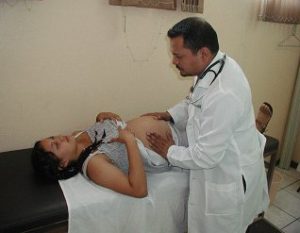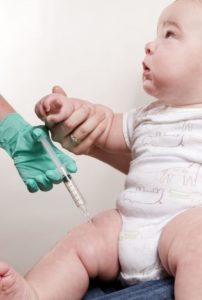Infant Care, Child and Adolescent Care, and Prenatal Care
Table of Contents
- Introduction
- Prenatal Care
- Preconception Visit
- Visit 1 (6–8 weeks)
- Visit 2 (10–12 weeks)
- Visit 3 (16–18 weeks)
- Visit 4 (22 weeks)
- Visit 5 (28 weeks)
- Visit 6 (32 weeks)
- Visit 7 (36 weeks)
- Visit 8-11 (38-41 weeks)
- Visit Post-Partum (4-6 weeks)
- Diet in Pregnancy
- Examination of the Healthy Infant
- Addressing concerns during infancy
- Examination of healthy children and adults
- References
Image: “A human male baby, crying.” by Evan-Amos – Own work. License: Public Domain
Introduction
Mother and infant care start before the time of delivery. Prenatal care revolves around screening maneuvers, counseling, education and intervention, and immunization and chemoprophylaxis. Based on the guidelines, a minimum of 13 visits to the gynecologists is scheduled for prenatal care, including the preconception and postpartum visit. The first examination visit for ensuring the health of an infant is scheduled after 3—5 days of birth. Other visits are scheduled as follows:
- 1 month
- 2 months
- 4 months
- 6 months
- 9 months
- 12 months
Prenatal Care
Schedule for Routine prenatal care
- Monthly through 28 weeks EGA
- Bimonthly 28—36 weeks EGA
- Weekly until delivery
This schedule is for a normal healthy woman. Those with a history of diabetes and complicated pregnancy may require more care and various appointments.
Landmarks for visits
Each visit consists of all or at least 1 of the following:
- Screening maneuvers
- Counseling, Education, and Intervention
- Immunization and Chemoprophylaxis
Following are the landmarks of visits to a gynecologist before and during pregnancy:
Preconception Visit
A. Screening maneuvers
1. Profile assessment is completed to check for the following preconception risks
- Infectious disease risk
- Genetic risk
- The potential for vaginal birth after Caesarean (VBAC)
- Workplace and lifestyle hazard assessment
- Preterm labor risk
2. Other screening maneuvers include
- Blood pressure
- History and physical
- Rubella
- Varicella
- Cervical cancer screening
- Domestic violence
- Depression
B. Counseling, Education, and Intervention: Information and counseling on following are conveyed to the expecting mother
- Preterm labor
- Substance use/abuse
- Domestic violence
- Nutrition and weight
- Need for recording menstrual dates
- Medications, herbal supplements, and vitamins
C. Immunization and Chemoprophylaxis
Visit 1 (6–8 weeks)
A. Screening maneuvers
Profile assessment is completed to check for the following risks:
- Blood pressure
- History and physical
- Rubella
- Varicella
- Cervical cancer screening
- Domestic violence
- Depression
- GC/Chlamydia
- CBC
- ABO/Rh/Ab
- Urine culture
- Viral hepatitis
- Syphilis
- Blood lead screening
- HIV
B. Counseling, Education, and Intervention
- Preterm labor and VBAC
- Discuss fetal aneuploidy screening
- Prenatal and lifestyle education
- Physical activity
- Follow-up of modifiable risk factors
- Warning signs
- Nutrition
- Nausea and vomiting
- Course of care
- Pregnancy physiology
C. Immunization and Chemoprophylaxis
Visit 2 (10–12 weeks)
A. Screening maneuvers
- Blood pressure
- Weight
- Auscultation of fetal heart tones
- Fetal aneuploidy screening
B. Counseling, Education, and Intervention
- Preterm labor education
- Prenatal and lifestyle education
- Fetal growth
- Breastfeeding
- Review lab results from visit 1
- Pregnancy physiology
- Nausea and vomiting
- Follow-up of modifiable risk factors
Visit 3 (16–18 weeks)
A. Screening maneuvers
- Weight and blood pressure
- Fetal aneuploidy screening
- Auscultation of fetal heart tones
- OB ultrasound (optional)
- Depression
- Cervical assessment
- Fundal height
B. Counseling, Education, and Intervention
- Preterm labor education
- Preterm labor prevention
- Prenatal and lifestyle education
- Follow-up of modifiable risk factors
- Physiology of pregnancy
- Second-trimester growth
- Quickening
C. Immunization and Chemoprophylaxis
- Progesterone is recommended for women at high-risk for preterm delivery
Visit 4 (22 weeks)
A. Screening maneuvers
- Weight and blood pressure
- Fundal height
- Fetal heart tones
- Cervical assessment
B. Counseling, Education, and Intervention
- Preterm labor education
- Prenatal and lifestyle education
- Follow-up of modifiable risk factors
- Family issues
- Classes
- Length of stay
- GDM
- Preterm labor prevention
C. Immunization and Chemoprophylaxis
- Rho D Immune Globulin
Visit 5 (28 weeks)
A. Screening maneuvers
- Preterm labor risk
- Weight and Blood Pressure
- Fundal height
- Fetal heart tones
- Gestational diabetes mellitus
- Domestic violence
- Depression
- [Rh antibody status]
- [GC/Chlamydia]
- [Hepatitis B surface Ag]
B. Counseling, Education, Intervention
- Psychosocial risk factors
- Preterm labor education
- Awareness of fetal movement
- Preterm labor prevention
- Prenatal and lifestyle education
- Follow-up of modifiable risk factors
- Work
- Pregnancy physiology
- Preregistration
- Fetal growth
C. Immunization and Chemoprophylaxis
- ABO/Rh/Ab
- Rho D Immune Globulin
- Hepatitis B Ag
Visit 6 (32 weeks)
A. Screening maneuvers
- Weight and Blood Pressure
- Fetal heart tones
- Fundal height
B. Counseling, Education, Intervention
- Preterm labor education
- Prenatal and lifestyle education
- Follow-up of modifiable risk factors
- Travel
- Sexuality
- Contraception
- Episiotomy
- Pediatric care
- Labor and delivery issues (Preterm labor prevention)Warning signs of pregnancy-induced hypertensionVBAC
Visit 7 (36 weeks)
A. Screening maneuvers
- Weight and Blood Pressure
- Fundal height
- Fetal heart tones
- Confirm fetal position
- Cervix exam
- Culture for group B strep
B. Counseling, Education, Intervention
Prenatal and lifestyle education
- Follow-up of modifiable risk factors
- Postpartum care
- Management of late pregnancy symptoms
- Contraception
- When to call provider
- Discussion of postpartum depression
Visit 8-11 (38-41 weeks)
A. Screening maneuvers
- Weight and Blood Pressure
- Fundal height
- Fetal heart tones
- Cervix exam
B. Counseling, Education, Intervention
Prenatal and lifestyle education
- Follow-up of modifiable risk factors
- Infant CPR
- Postpartum vaccinations
- Post-term management
Labor and delivery update
Breastfeeding
Visit Post-Partum (4-6 weeks)
A. Screening maneuvers
- Cervical cancer screening
- GC/Chlamydia
- Height and weight
- History and physical
- Gestational diabetes mellitus
- Domestic violence
- Depression
B. Counseling, Education, Intervention
- Contraception
- Postpartum depression discussion
- Breastfeeding concerns and support
C. Immunization and Chemoprophylaxis
- Tetanus/Pertussis
Diet in Pregnancy
Safe: Moderate caffeine intake, artificial sweeteners, fish maximum 12oz per week
Unsafe: Saccharine, unpasteurized food, swordfish, shark or raw fish.
Weight gain goals in pregnancy:
- Normal: 25-35 lbs.
- Overweight: 15-25 lbs.
- Obese: 11-20 lbs.
Other counseling in pregnancy:
- Air travel is safe for the fetus for up to 36 weeks
- Moderate exercise for 30 minutes on most days of the week
- Avoid hair treatment
- Hot tubs and saunas are to be avoided during the first trimester of pregnancy
- Acetaminophen is the safest drug for pain relief
- Vitamin B6 and change in dietary pattern is recommended for moderate nausea and vomiting.
Examination of the Healthy Infant
Schedule
- 3-5 days after birth
- 1 month
- 2 months
- 4 months
- 6 months
- 9 months
- 12 months
Breastfeeding
Recommended as exclusive feeding for 6 months, with continuation through age 1 year.
Benefits for the infant
Decreased risk of:
- Asthma
- Obesity
- Diabetes
- Infections
- SIDS
Benefits for the mother
- Decreased risk of ovarian and breast cancer
- Improved bonding
Screening for neonatal jaundice
Preterm infants at high-risk monitor for jaundice in hospital every 8-12 hours
Use nanograms based on hours since birth for risk stratifications and choice to initiate phototherapy.
Do blood group and Coombs testing to check for rising bilirubin.
Infants with glucose-6-phosphate dehydrogenase deficiency are at a high risk of developing hyperbilirubinemia. Infants who are deficient in G6PD require intervention at a lower bilirubin concentration.
Prevention and treatment of neonatal jaundice
8—12 breast feeds per day
Do not reduce breastfeeding in the case of mild jaundice
The recommendation for treatment in the case of neonatal jaundice
Infants with severe hyperbilirubinemia or a high risk of developing severe hyperbilirubinemia should undergo intensive phototherapy.
Most cases do not require a neonatal intensive care unit (NICU) admission, but careful monitoring is a must.
Addressing concerns during infancy
Sleep
- Always on back to prevent Sudden infant death syndrome
- Avoid blankets, toys, bumpers
- 14-17 hours per day (newborns)
- 12-15 hours per day (infants)
- Most infants with inadequate night waking by age 6 months
- Watch out for parental anxiety and burnout.
- Emphasize bedtime routine
Pacifier use
- Improves risk of SIDS through 6 months
- May increase the risk of otitis media and wheezing
- Dental malocclusion is more common with pacifiers than thumb sucking
- Start weaning off pacifier at 6 months
Vaccinations
Infants and children are most vulnerable to potentially life-threatening diseases. Recommended vaccination schedules are aimed at the prevention of such diseases.
The previous connection between autism and vaccination has been disproved.
Maintain adherence to CDC/ACIP recommendations.
Failure to thrive (FTT)
If a child’s weight is less than other children of similar age and gender, it means the child is failing to thrive. Measurements for FTT include both the current weight and the rate of weight gain.
Causes
Social issues are responsible for over 80 % of cases of FTT.
FFT can be due to medical causes. These include:
- Genetic disease such as Down syndrome
- Endocrine problems
- Organ problems
- Blood disorders
- Heart or lung problems affecting the blood circulation and oxygenation
- Damage to the brain or CNS resulting in feeding difficulties in an infant
- Gastrointestinal problems such as lack of digestive enzymes
- Chronic infections
- Metabolic problems
- Low birth weight
FTT could be a result of child’s environment:
- Lack of emotional bond between parent and child
- Child-caregiver related problems
- Poverty
- Exposure to infections, toxins, and parasites.
- Lack of understanding on parents behalf regarding child’s nutritional needs
- Poor eating habits such as not having formal meal timings
Many times, the cause cannot be determined.
Lab testing for FTT: CBC, CMP, UA and culture, TSH, ESR
Lab testing identifies the cause of FTT in only 1 % of routine cases.
Examination of healthy children and adults
Important screening during early childhood
- Birth history
- Development
- Home environment
- School readiness
- Diet
- Physical activity
- Sleep
Head to toe examination
- BMI
- Cardiac exam
- Hips (through age 2 years)
- Genitalia
Recommended screening exams among children
- Hgb at one year (often done annually through age 5 years)
- Consider Fluoride varnish at age 6 months to 5 years
- Hearing and vision tests by 4 years
- Lipid screening – 9—11 years of age and again in late adolescence
- Lead, T.B screening in at-risk children
Vaccinations
The first dose of Meningococcal vaccines is given at age 11 through 12 years, followed by a booster dose at 16 years of age.
For other vaccinations, maintain adherence to CDC/ACIP recommendations.
Autism spectrum screening
USPSTF does not recommend screening for Autism.
AAP recommends validated tool at age 18 and 24 months
Early invasive behavioral therapy (> 25 hours/week) results in better:
- Language ability
- Cognitive ability
- Adaptability
Recommended screening exams among adolescents
- BMI at every general exam
- Chlamydia and gonorrhea screening among sexually active females
- Drugs
- Alcohol use
- Home and Environment
- Education and employment
- Depression
- Activities
Risky behavior among adolescents
- Alcohol
- Drugs
- Sexual activity



Comentários
Enviar um comentário